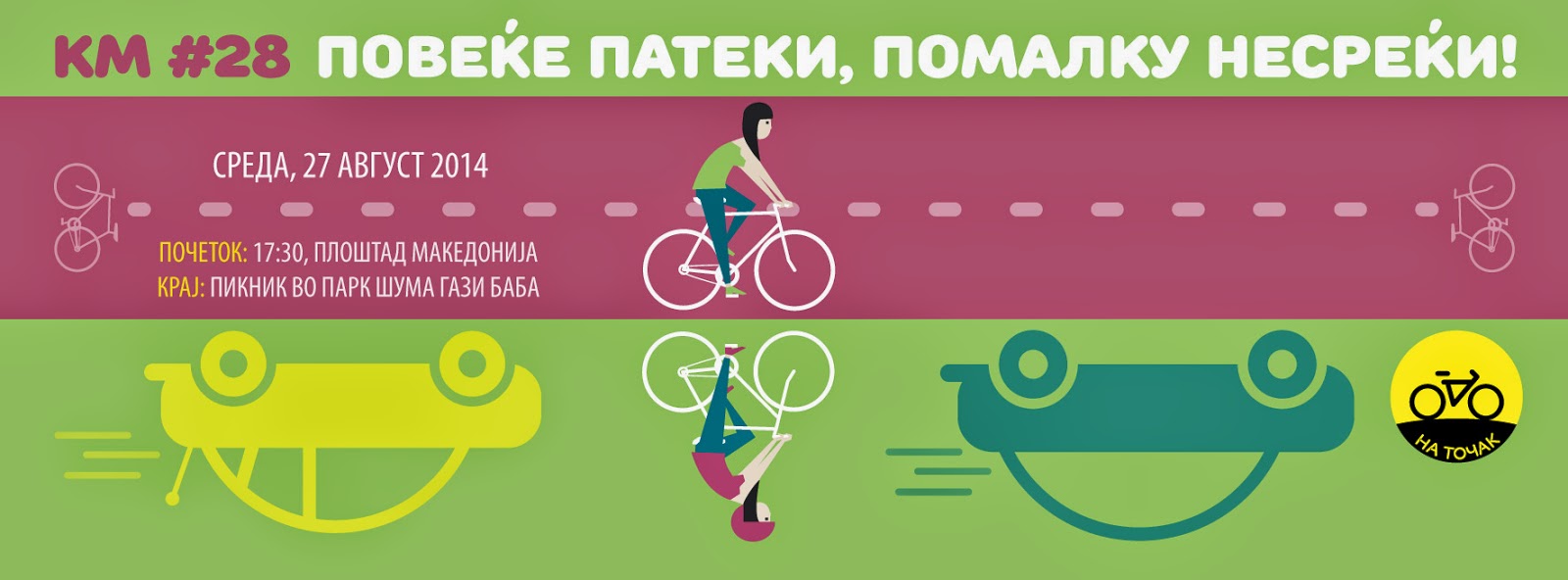NaTochak and eleven
other organizations firmly believe that the mandatory use of protective bicycle
helmets should not be introduced in Macedonia, and have sent a letter to all
responsible institutions.
The text of this letter is quoted in full in this blog/post.
The letter was sent to:
1. The Ministry of Transport and Communications: Department
for Normative, Legal and Administrative Affairs, Department for the European
Union, Department for Spatial Management,
2. The National Council for Road Traffic Safety,
3. The Ministry of Interior,
4. The Traffic Department of the City of Skopje.
(Also the letter in Macedonian here)
Dear Sir/Madam,
We would like to bring
your attention to the proposed changes in the existing legislation and possible
introduction of mandatory bicycle helmets, according to some Macedonian media.
From what we could read
in this article in the Denesen newspaper, http://denesen.mk/web/?p=261319, amendments have been proposed to the Law on Traffic
Road Safety, according to which the wearing of a protective bicycle helmet is
to be made mandatory in addition to the requirement for a proper reflecting
light equipment on bicycles.
The NaTochak (OnBike)
initiative welcomes all measures aimed at enhancing the safety of cyclists and
at the same time increasing the appeal of the bicycle as a means of transport
for new cyclists.
We believe that the
introduction of a required protective helmet when using the bicycle as a means
of transport runs contrary to the efforts for increasing its share in traffic.
Looking into this subject,
we have came across a lot of data and scientific studies as well as views by
relevant institutions and organizations for urban cycling not favouring regulations
for a mandatory use of bicycle helmets.
In order to maintain
and promote the positive trend of a rising number of cyclists in cities
throughout Macedonia, an atmosphere of fear should not be created and bicycles
should not be perceived as an unsafe means of transport, or cities as not being
safe for cyclists.
The proposed required
protective helmet will definitely lead to a fall in the number of active
cyclists and create a picture among potential cyclists that cycling is
dangerous.
·
Cyclists
are not more prone to major head injuries than car drivers and pedestrians, while
these are not required to wear helmets.
http://www.howiechong.com/journal/2014/2/bike-helmets?fb_action_ids=10152475821825864&fb_action_types=og.likes#.U9Dd5ZSSyLh h
http://www.howiechong.com/journal/2014/2/bike-helmets?fb_action_ids=10152475821825864&fb_action_types=og.likes#.U9Dd5ZSSyLh h
·
The
conclusion of the aforementioned study is that one of the more effective ways
of improving the safety of pedestrians and cyclists is by increasing their
number. The mandatory use of helmets would run contrary to that goal.
http://injuryprevention.bmj.com/content/9/3/205.abstract
http://injuryprevention.bmj.com/content/9/3/205.abstract
·
The mandatory
use of helmets only complicates the public bicycle renting system. The
management of that system also has to provide those renting bicycles with
helmets as well as their proper storage and control.
The
European Cycling Federation, the highest
authority on urban cycling in Europe and the world, recommends, based on
extensive research, that no regulations on the mandatory use of protective
helmets should be introduced:
http://www.ecf.com/advocary/road-safety/helmets-and-reflective-vests/
http://www.ecf.com/advocary/road-safety/helmets-and-reflective-vests/
2 In most EU countries the
helmet is not considered required equipment. The following link: http://ec.europa.eu/transport/road_safety/going_abroad/netherlands/safety_helmet_en.htm
lists the European legislation for each member of the Union, and the map can be found here:
http://helmetfreedom.org/847/bicycle-helmet-law-map/
lists the European legislation for each member of the Union, and the map can be found here:
http://helmetfreedom.org/847/bicycle-helmet-law-map/
Rather than
mitigate the effects of possible accidents with minimum safeguards such as the
helmet while causing damage in other fields, we should take appropriate
measures to prevent these accidents from happening in the first place:
1. By investing in a separate and proper
cycling infrastructure that will permit free-flowing bicycle traffic, safe
and not conflicting with motor vehicle traffic, from which the helmet should only
be a theoretical protection, and reducing the speed limits for motor vehicles
in parts of the city where it is impossible to separate cycling from motor
vehicle traffic;
2. By promoting
traffic education programmes for all participants in traffic, through both formal
education and campaigns.
These measures have proved successful in countries known
for the highest safety of their cyclists – in the Netherlands and Denmark. Bicycle
helmets are not mandatory there.
In the following study we can clearly see that both the
development of bicycle traffic and safety have suffered in the countries introducing
the mandatory use of bicycle helmets:
http://www.cyclehelmets.org/papers/c2034.pdf
http://www.cyclehelmets.org/papers/c2034.pdf
Now that there has
been at least a slight increase in the interest among our fellow citizens in the
bicycle as a means of transport, let us not take a step back by complicating
the legislation on potential victims. Let us move forward by improving cycling
conditions on a long-term basis.
We sincerely hope
that you will consider the views expressed in this document which is supported
by the following organizations:
1. NaTochak (OnBike),
Skopje
2. Macedonian
Bicycle Federation
3. To4ak (Bike)
4. Coalition for Sustainable
Development
5. Go Green
6. Eco Awareness
7. Milieukontakt
Macedonia
8. Eco Logic
9. Tetovo on Bike
10. Gostivar
on Bike
11. Bitola on
Bike
12. Prilep on
Bike





 19:57
19:57
 На Точак
На Точак















